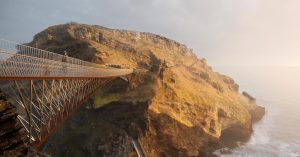Philip Hayward, ‘Tintagel Island as a rhetorical construct, disputed heritage asset and bridged peninsula’, Journal of Marine and Island Cultures 11, 2 (2022), pp. 215-225 and ‘St Ives Island: the persistent mischaracterisation of a Cornish headland’, Journal of Marine and Island Cultures 11, 2 (2022), pp. 53-63 (available online at https://jmic.online/issues/v11n2/4/)
When is an island not an island? When it’s an ‘almost-island’. Philip Hayward has followed up his article on Cornwall as an almost-island by focusing in on two almost-islands at a substantially smaller scale. St Ives and Tintagel provide an illuminating contrast.
The geographical definition of an island is a body of land surrounded by water. Neither St Ives Island nor Tintagel Island fit that definition. In fact, they are both peninsulas, attached to the rest of the land by an isthmus. Yet, their island characterisation endures because their metaphoric status as islands, outweighs the boring definitions of geographers.
At St Ives, the Island has been as known as such since at least 1620. Although a persistent local myth insists it was once detached from the rest of St Ives, there’s no proof that this was ever the case. Over time, St Ives has experienced an extension of islandness. When the narrow streets to the south of the Island were built up in the nineteenth century the Island placename was extended to encompass them.
The tourist take-over of St Ives has enabled St Ives Island to become more of a metaphoric island, in the sense of being an island of serene calm separate from the manic congestion and bustle of the town’s streets. This image feeds into the marketing of events such as the annual Summer Island Disco or St Ives Island Rum, appealing to the allure of real islands.

While St Ives Island has been confirmed in its islandness, Tintagel Island has recently seen developments that could potentially erase its metaphoric islandness. Like the Island at St Ives, Tintagel Island is joined to the coastline by a narrow strip of land, albeit much eroded since early medieval times. Hayward suggests that the appellation ‘island’ is rather recent, with no evidence of its use before the mid-1800s. He suggests it was part of a set of toponymic shifts that took place in the nineteenth century that also saw the nearby village of Trevena take on the name Tintagel. In fact, there’s a reference to the headland as ‘the island of Tintagel’ as early as the 1200s.
Be that as it may, Tintagel Island’s considerable archaeological riches and the Arthurian connotations of its castle have given it a growing prominence since the late 1800s. Since the 1980s this Cornish heritage icon has been overseen by the provocatively named English Heritage. Philip Hayward neatly summarises the spluttering campaign of resistance against what might be viewed either as a heavy-handed attempt to impose cultural uniformity on Cornwall or a blundering act of avoidable stupidity by authorities ignorant of Cornwall’s history.
In 2019 a spanking new bridge was completed to link Tintagel Island to the nearby cliffs. Its construction was a divisive project subject to competing discourses, which are detailed by Hayward. For its supporters it was inevitably seen as modernity and progress, an attraction in itself while improving access (greatly exaggerated as it’s unclear where wheelchair users, for example, would go once over the bridge and onto the island.)

From the perspective of the bridge’s supporters, including Cornwall Council, tourist promoters and, more surprisingly (although perhaps less so given English Heritage’s control of the purse strings) most archaeologists, the detractors were mired in pre-modernity and nostalgia. Those less enamoured of the project included Cornwall’s AONB managers, some conservationists and Cornish nationalists. Yet, as Philip Hayward points out, the bridge can also be seen as evidence of English Heritage’s priorities, which place customer maximisation and income generation above respect for place. Furthermore, the bridge may also significantly impact on Tintagel Island’s status as an island by undermining its remoteness, formerly guaranteed and symbolised by the difficulty of access.
While at St Ives therefore, islandness has been extended despite tourism, at Tintagel islandness may be in the process of being erased by the pressures of tourism. It’s worth quoting Philip Hayward’s conclusion in full. ‘In this manner, English Heritage has transformed (rather than ‘enhanced’) Tintagel Island, erasing the ‘inconvenience’ of its dipping isthmus in favour of a seamless integration to the coastal cliffs by means of a linear, fixed link that exemplifies modernity and metropolitan nationalist agendas and decision-making processes’.